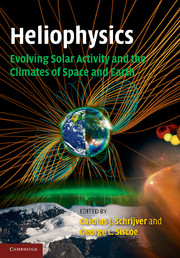Book contents
- Frontmatter
- Contents
- Preface
- 1 Interconnectedness in heliophysics
- 2 Long-term evolution of magnetic activity of Sun-like stars
- 3 Formation and early evolution of stars and protoplanetary disks
- 4 Planetary habitability on astronomical time scales
- 5 Solar internal flows and dynamo action
- 6 Modeling solar and stellar dynamos
- 7 Planetary fields and dynamos
- 8 The structure and evolution of the three-dimensional solar wind
- 9 The heliosphere and cosmic rays
- 10 Solar spectral irradiance: measurements and models
- 11 Astrophysical influences on planetary climate systems
- 12 Assessing the Sun–climate relationship in paleoclimate records
- 13 Terrestrial ionospheres
- 14 Long-term evolution of the geospace climate
- 15 Waves and transport processes in atmospheres and oceans
- 16 Solar variability, climate, and atmospheric photochemistry
- Appendix I Authors and editors
- List of illustrations
- List of tables
- References
- Index
- Plates
15 - Waves and transport processes in atmospheres and oceans
Published online by Cambridge University Press: 05 April 2013
- Frontmatter
- Contents
- Preface
- 1 Interconnectedness in heliophysics
- 2 Long-term evolution of magnetic activity of Sun-like stars
- 3 Formation and early evolution of stars and protoplanetary disks
- 4 Planetary habitability on astronomical time scales
- 5 Solar internal flows and dynamo action
- 6 Modeling solar and stellar dynamos
- 7 Planetary fields and dynamos
- 8 The structure and evolution of the three-dimensional solar wind
- 9 The heliosphere and cosmic rays
- 10 Solar spectral irradiance: measurements and models
- 11 Astrophysical influences on planetary climate systems
- 12 Assessing the Sun–climate relationship in paleoclimate records
- 13 Terrestrial ionospheres
- 14 Long-term evolution of the geospace climate
- 15 Waves and transport processes in atmospheres and oceans
- 16 Solar variability, climate, and atmospheric photochemistry
- Appendix I Authors and editors
- List of illustrations
- List of tables
- References
- Index
- Plates
Summary
Waves in planetary atmospheres are interesting in their own right, but their importance lies mostly in the effects they have on the background atmosphere. Gravity waves may transport momentum, heat, and minor constituents through wave fluxes and may mix the atmosphere through the turbulence they induce when they break down (Lindzen, 1981; Fritts, 1984; Garcia and Solomon, 1985; Walterscheid, 1981, 1995, 2001; Walterscheid and Schubert, 1989). Planetary waves transport heat, momentum, and constituents (e.g. ozone) latitudinally and play a significant role in the heat, momentum, and ozone budgets (Holton and Wehrbein, 1980; O'Sullivan and Salby, 1990; Fusco and Salby, 1999).
Atmospheric waves
Planetary atmospheres admit a rich variety of waves. These waves involve to varying degrees the rotational, compressional, and buoyant properties of a fluid in motion. Many wave disturbances arise in instabilities, including those that give rise to weather systems. Other motions arise as free waves or waves forced by agents external to the atmosphere (e.g. planetary topography and s olar heating). These comprise two broad classes of waves in planetary atmospheres: Rossby waves and gravity waves. Rossby waves are the comparatively low-frequency waves that dominate the ultra-long wave field in the lower atmosphere. Rossby waves are rotational waves where latitudinal displacements are opposed by the latitudinal gradient of planetary rotation. Gravity waves, in contrast, are comparatively high-frequency divergence waves where vertical displacements are opposed by pressure forces induced by gravity.
- Type
- Chapter
- Information
- Publisher: Cambridge University PressPrint publication year: 2010

